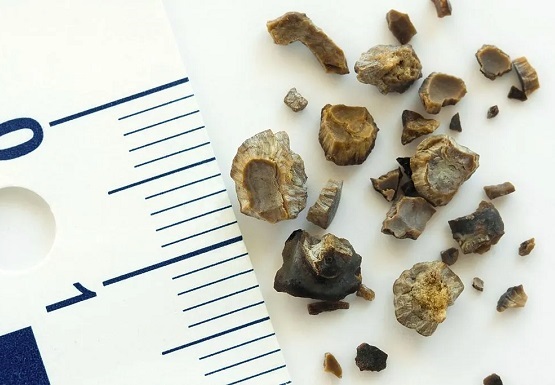The Urinary Stone

Urological diseases can refer to a wide spectrum of conditions related to the urinary tract that transports urine out of our body and the male reproductive organs. The field of urology treats a myriad of diseases which include the genitourinary tract cancers such as kidney, bladder and prostate cancers, urinary tract infections, prostate diseases and men’s health like erectile dysfunction and andro-pause. One of the most common urological diseases developing in Singapore is urinary stone disease, probably in part, because of our hot tropical climate which leaves many people susceptible to the medical condition.
Not any stone
“About 10 per cent of males and 5 percent of females in our population will experience urinary stone disease in their lifetime. Most of these individuals would not realise they have urinary stones until he or she develops an episode of severe abdominal pain, spurring them to seek emergency medical attention,” Dr Ong said.
“Dehydration is a big factor for urinary stones to develop, especially in Singapore. In setting of dehydration, our urine becomes more concentrated and supersaturated with mineral crystals. The precipitation of these crystals would then lead to stone formation over time. For some females, urinary stones may also be associated with sub-clinical chronic urinary tract infection. Some urinary tract bacteria are capable of producing enzymes which are able to initiate and promote formation of stones in these patients” he explained.
Urinary stones are pieces of solid material that form in the kidney when certain minerals such as calcium, oxalate, phosphate and uric acid in the urine becomes supersaturated. Very small stones of less than two millimetres usually pass through the urinary tract with minimal discomfort, but larger stones can result in severe pain when they cause blockage to the urinary tract.
While anyone can develop urinary stones, there are two particular groups that are at higher risk.
“Men aged between 20 and 30 who work outdoors and tend to get dehydrated often, leading to concentrated urine and consequently, urinary stone formation. Another group is aged between 50 to 60; they have comorbid diseases like diabetes, obesity and gout that predisposes them to risk of developing urinary stones.”
Stone formation
Apart from dehydration, our daily diet can also be another factor causing urinary stones formation.
“A diet that is high in beans, nuts, animal protein and even green leafy vegetables can potentially cause urinary stones. The constituents or by-products of these foods give rise to calcium and sodium salts, uric acids and oxalates in the urine in high concentration. Realistically, it is difficult to avoid these foods altogether in our daily diet, so the general advice for my ‘stone’ patients is to eat these foods in lesser quantity and in moderation,” Dr Ong added.
Genetic pre-disposition is another important cause. “Some urinary stone patients have close family members who suffer from similar disease, and these individuals may have inherited various genetic traits that predisposes them to urinary stone formation e.g. cystinuria with cysteine stones,“ said Dr Ong.
Lastly, obesity is also a known risk factor for urinary stones. Excess nutritional intake increases substances such as calcium, oxalate and uric acid excreted in the urine, and being obese also results in increased urine acidity. A combination of these can act to increase the likelihood of urinary stone formation.
While all the discussions above alluded to lifestyle and diet as the main cause of urinary stone disease, the truth is that urinary stones are not afflictions of our modern lifestyle. Urinary stones have even been found in the post mortem of ancient Egyptian mummies – which is one of mankind’s earliest civilisation, Dr Ong clarified.
Treatment
A urinary stone “attack” or medically known as “renal colic” can be one of the most painful experience anyone can ever experience. The good news according to Dr Ong is that up to 80% of these stones are small i.e. less than five millimetres in diameter, and would pass out spontaneously by the patient. A urologist would usually treat these stones with combination of oral painkiller, anti-inflammatory and muscle relaxant, also known at Medical Expulsion Therapy (MET). “It can take anytime from one day to four weeks for the stone to pass out after MET is instituted,” said Dr Ong.
Bigger stones that are more than five millimetres in diameter have much lower chances of passing out spontaneously and are at risk of causing persistent pain, secondary infection and irreversible damage to the kidney. Such stones often would need early urological intervention. “The good news is, unlike the old days where the discovery of larger urinary stones meant the need for invasive open surgery with big incision and prolonged hospital recovery, modern stone treatment is now minimally invasive and achieves very good results,” added Dr Ong.
Extracorporeal Shock Wave Lithotripsy (ESWL), which uses acoustic pulses applied externally to break up urinary stones, is the least invasive and very acceptable to most patients. “With the patient on the couch, the urologist locates the stones using X-rays and then focuses acoustic pulses on them with the ESWL machine. This will gradually fragment the stones into smaller pieces. The patient will then subsequently pass out these fragments through their urination,” he explained. Such procedure takes about one hour and is routinely performed as a day surgery. The patient can resume their normal activities as early as the following day.
When ESWL is not suitable due to the stone size or position, a ureteroscopy can be performed instead. Ureteroscopy is performed under anaesthesia, whereby a thin telescope is put up the urinary tract to locate the stones. Once the stone is visualised it can then be broken down using a laser fibre or be removed. Again, such procedure is minimally invasive and the patient may not need to stay in the hospital overnight.
Checking for stones
Many times, small stones will pass out spontaneously, but close follow-up with a urologist is still essential to prevent complications.
“The urinary stone symptom of pain can sometimes get better itself, so some patients assumed the stone has been passed out when it hasn’t. The stone would then continue to block the kidney resulting in permanent damage to the kidney in the long term.” It is for this reason a urologist often uses X-rays or ultrasound to reliably ascertain if the offending stone has been passed out.
The best treatment for urinary stone is perhaps the prevention of stone formation. “The risk will be lower for those who take more fluid in excess of two litres. And those who have recurring stone formation should drink at least two litres a day,” said Dr Ong.
Besides drinking sufficient fluid, Dr Ong recommends that one should limit their intake of salt, nuts, meat and animal proteins. Stone inhibitors like citrate which is found in lime or lemon juice, may also help in reducing the risk of urinary stone formation.
Article contributed by Dr Ong Chin Hu, an accredited doctor of Mount Alvernia Hospital.
ACE Urology Clinic & Surgery
Mount Alvernia Hospital
Medical Centre Blk D, Unit #07-56
Tel: (+65) 6255 1005
